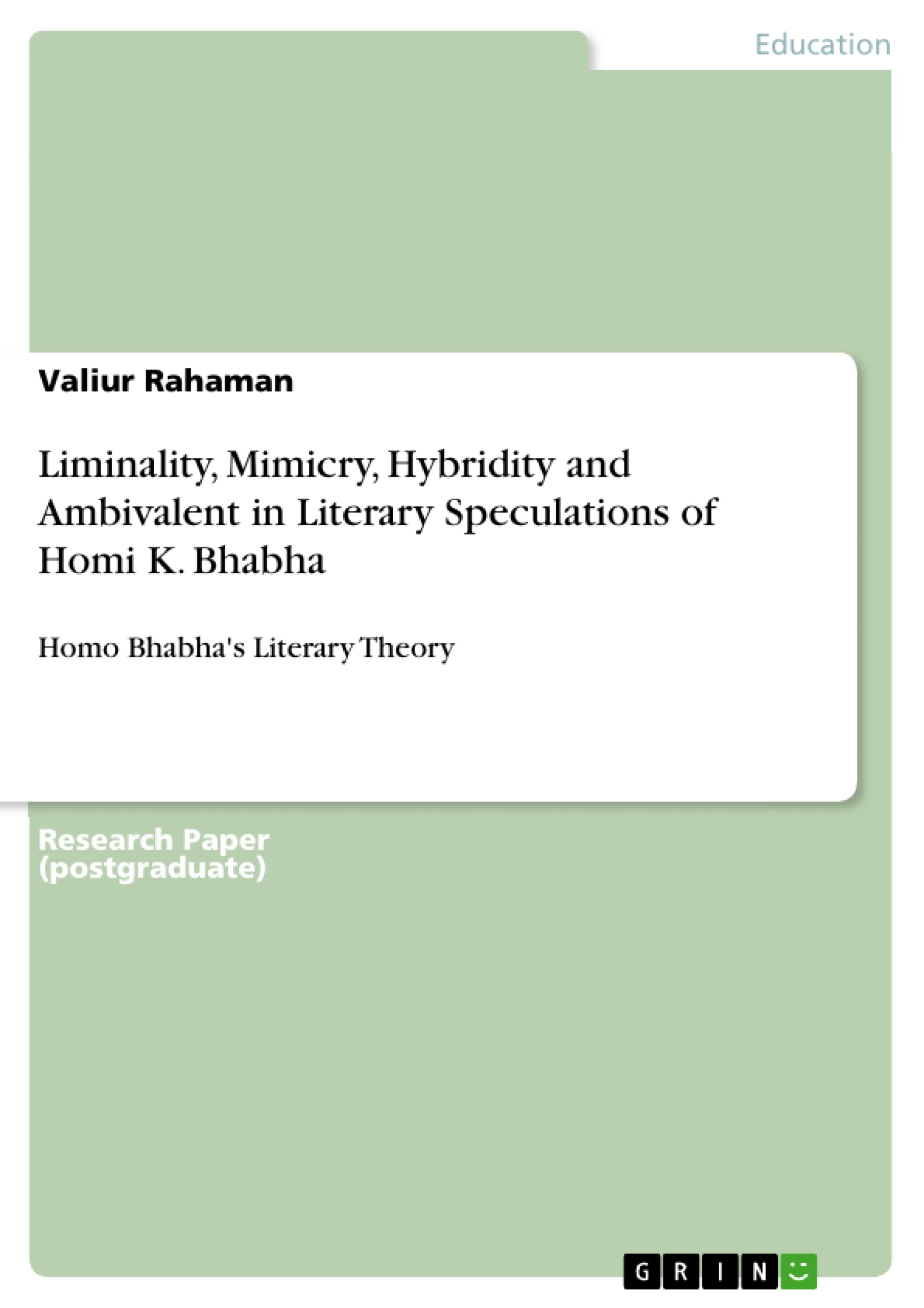Objective of this paper is to discuss how culture of a nation gets formed strongly and how it affects literature of that very nation. Homi Bhabha's Location of Culture is found sufficient example of thinking culture as epesteme of mimicry,liminality and hybridity of its ur-culture. The proposed paper elucidates and illustrates ideas of Homi K Bhabha, he has given in Location of Culture.
Table of Contents
- Liminality, Mimicry, Hybridity, and Ambivalent in Literary Speculations of Homi K. Bhabha
Objectives and Key Themes
This text aims to provide an analysis of Homi K. Bhabha's key concepts—liminality, hybridity, mimicry, and ambivalence—and their application in understanding postcolonial culture and identity. The analysis explores how Bhabha uses these concepts to examine the complexities of cultural interaction, resistance, and the ongoing negotiation of identity in the postcolonial world.
- Bhabha's concepts of liminality, hybridity, mimicry, and ambivalence.
- The application of these concepts to postcolonial literature and cultural studies.
- The critique of essentialist notions of culture and identity.
- The dynamics of power and resistance in colonial and postcolonial contexts.
- The concept of the "Third Space of Enunciation" as a site of cultural hybridity.
Chapter Summaries
Liminality, Mimicry, Hybridity, and Ambivalent in Literary Speculations of Homi K. Bhabha: This chapter introduces Homi K. Bhabha and his influential work in postcolonial theory. It explores his key concepts: liminality, hybridity, mimicry, and ambivalence, which are presented as crucial for understanding the complex cultural dynamics of colonialism and its aftermath. The chapter establishes these concepts as tools for analyzing how colonized peoples resist colonial power, demonstrating the inherent instability of colonial authority and the continuous interplay between dominant and subordinate cultures. It lays the groundwork for subsequent analyses of Bhabha's work, highlighting the significance of his deconstructive approach and its implications for understanding culture as a site of constant negotiation and transformation. The chapter draws on Derrida's concept of the margin to frame Bhabha's ideas, emphasizing the productive nature of liminal spaces and the challenge to fixed notions of cultural identity. Examples from postcolonial literature and history are briefly mentioned, setting the stage for a deeper examination in subsequent sections. The chapter also explores the meaning of ambivalence, explaining it as a state encompassing both positive and negative aspects, inherently linked to hybridity and cultural change in postcolonial contexts. The discussion touches on the mutual influence between colonizer and colonized, emphasizing that the creation of new cultural forms in the contact zone is a characteristic feature of post-colonial societies. The chapter concludes by introducing the concept of liminality, drawing on anthropological theories of ritual and transition, and highlighting its relevance to Bhabha's understanding of cultural hybridity.
Keywords
Postcolonial theory, Homi K. Bhabha, liminality, hybridity, mimicry, ambivalence, cultural identity, colonial discourse, resistance, Third Space of Enunciation, postcolonial literature.
Frequently Asked Questions: Liminality, Mimicry, Hybridity, and Ambivalence in Literary Speculations of Homi K. Bhabha
What is the main focus of this text?
This text provides a comprehensive analysis of Homi K. Bhabha's key concepts – liminality, hybridity, mimicry, and ambivalence – and how they apply to understanding postcolonial culture and identity. It explores how Bhabha uses these concepts to examine the complexities of cultural interaction, resistance, and the ongoing negotiation of identity in postcolonial societies.
What are Bhabha's key concepts discussed in this text?
The text focuses on four key concepts developed by Homi K. Bhabha: liminality (the in-between space), hybridity (the mixing of cultures), mimicry (the imitation of the colonizer), and ambivalence (the coexistence of opposing feelings or ideas). These concepts are central to understanding the dynamics of power and resistance in colonial and postcolonial contexts.
How does the text apply Bhabha's concepts?
The text applies Bhabha's concepts to analyze postcolonial literature and cultural studies, critiquing essentialist notions of culture and identity. It examines the dynamics of power and resistance, focusing on the "Third Space of Enunciation" as a site of cultural hybridity where new cultural forms emerge from the interaction between colonizer and colonized.
What is the "Third Space of Enunciation"?
The "Third Space of Enunciation" is a concept central to Bhabha's work. It refers to a space of cultural hybridity where new meanings and identities are created through the interaction and negotiation between dominant and subordinate cultures. It's not simply a blending, but a complex process of resistance and re-creation.
What is the significance of liminality in Bhabha's work?
Liminality, drawing on anthropological theories of ritual and transition, is presented as a crucial element in understanding cultural hybridity. It highlights the productive nature of in-between spaces and challenges fixed notions of cultural identity. These liminal spaces are where resistance and the formation of new identities occur.
What is the role of ambivalence in postcolonial contexts according to Bhabha?
Ambivalence, characterized by the simultaneous presence of positive and negative aspects, is presented as an inherent feature of hybridity and cultural change in postcolonial societies. It reflects the complex and often contradictory relationship between colonizer and colonized, highlighting the mutual influence in the creation of new cultural forms.
What is the overall argument or conclusion of the text?
The text argues that Bhabha's concepts of liminality, hybridity, mimicry, and ambivalence provide crucial tools for understanding the complex and dynamic nature of postcolonial culture and identity. His work challenges essentialist views and highlights the ongoing negotiation and transformation of cultural meanings in the aftermath of colonialism.
What are the key words associated with this text?
Key words include: Postcolonial theory, Homi K. Bhabha, liminality, hybridity, mimicry, ambivalence, cultural identity, colonial discourse, resistance, Third Space of Enunciation, postcolonial literature.
What does the text include besides the analysis of Bhabha's concepts?
In addition to the analysis of Bhabha's concepts, the text provides a table of contents, chapter summaries, objectives, and key themes, offering a comprehensive overview of its content.
- Arbeit zitieren
- Dr Valiur Rahaman (Autor:in), 2010, Liminality, Mimicry, Hybridity and Ambivalent in Literary Speculations of Homi K. Bhabha, München, GRIN Verlag, https://www.grin.com/document/163237



